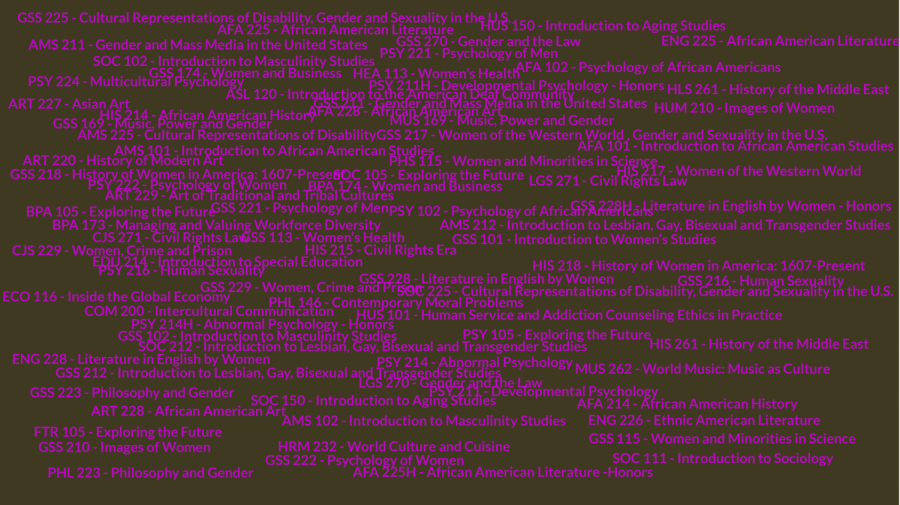Faculty supports diversity requirement; few students know what it is
AACC has a diversity requirement for it’s degrees, these are the individual courses that can be used for them.
April 4, 2019
While faculty members at AACC told Campus Current the diversity requirement is important, a survey revealed not many students knew anything about it.
In an informal poll at the Arnold campus, 3 out of eleven students knew about the requirement.
Dr. Heather Rellihan, the gender and sexuality studies coordinator and other faculty members stated AACC’s diversity requirement is important, but only three of eleven students interviewed for this article even knew what it was.
“One of the things that we offer at this college which I feel is one of the most important aspects of our curriculum is our diversity requirement,” Dr. Heather Rellihan, the gender and sexuality studies coordinator said.
“The idea of a diversity requirement stems from the same idea that black history month and women’s history month stem from: history and other kinds of cultural narratives are written by those in power… about themselves,” she said.
Rellihan said the diversity requirement is critical to helping students challenge dominant cultural narratives both in and out of the classroom.
“And I can tell you my own personal story,” she began. “When I finished high school, if you had asked me to name five women who had contributed to American history, I don’t think I would have been able to.”
“And it wasn’t because I wasn’t a good student; it just wasn’t a part of my curriculum,” she said. “And to the extent that women were talked about, they were always a footnote. There was often in the text, the actual construction of the textbook would marginalize them … there would be a boxed-out section for a ‘notable woman.’”
“The diversity requirement is an essential part of our education here,” she added. “Not only does it teach students, [but] it gives students the opportunity to explore some of the stories that haven’t been taught to them in their K-12 education.”
However, many students seem to be unaware of the requirement.
“I don’t really know anything about it,” Amaya Moody, a first-year transfer studies student said. “When I first came here I just met with a general adviser. We looked at what I had taken at Towson University and what would transfer.”
Kate Morgan, a first-year nursing student, similarly said she was “not aware of the diversity requirement.”
This is despite having had numerous meetings with various advisers over her high school AP classes and how they would meet program requirements.
“I’ve heard of [the diversity requirement], but I’m not sure of the classes [that satisfy it],” Jay Lee, a second-year transfer studies student said.
First-year transfer studies student Donavan Dredden and second-year film animation student Trevor Ross each said they had not heard of the requirement despite having spoken to their advisers about what classes to take for their programs.
“I last spoke to [my adviser] in December,” Ross said. “And he didn’t mention it. Or at least I don’t recall that requirement specifically. We talked about a lot of things.”
“My adviser told me,” said Zack Smith, second-year architecture student.
“My adviser was super helpful,” said Chloe Neis a second-year nursing student. “But the answer is yes and no. I already knew about the diversity requirement because it was on the nursing program course list and it was in the [catalogue].”
Still, answers like Rebecca Anderson, first-year radiology technician student, were more common.
“My adviser did not talk to me about the diversity requirement. I’ve heard of it, but I don’t know exactly what it is,” she said.
Spanish professor Jodie Hogan’s suggestion to seek diversity through the examples used in class is one possible solution for this awareness problem.
“The most organic way a teacher can incorporate diversity purposefully,” Hogan explained, “would be to create situations where what [students] are studying could be applicable to a different group in or out of the US.”
As a former STEM Spanish teacher, Hogan gave an example from math.
“Math word problems could easily be linked to other cultures,” she said. “You don’t have to change an entire curriculum, just change the examples.”
“Is there a problem that can be solved in a country in Africa, Asia, or the Middle East using computer science?” She asked. “This is what we did in STEM Spanish. I had students do real world problem-solving…students had to research other countries and what they would need to know to put their NGO there.”
Regarding the demographic future of most fields, Scott Cooper, French professor and world languages chair, noted at their recent high school world languages competition roughly “75% of the competitors were young women.”
He added that most of their department’s language texts seek gender equality in their examples.
However, Rellihan points out gender diversity in terms of transgender and non-binary individuals remains a concern.
“It matters what’s in the texts,” she said. “All of this sends messages about who is expected to be a leader in the field.”
Rellihan explained the ability to analyze these messages is why AACC’s diversity requirement remains important.












